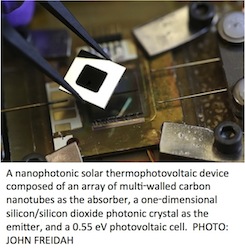MIT researchers have developed a new approach to harvesting solar energy. The technique uses sunlight to heat high-temperature materials whose infrared radiation would be collected by a conventional photovoltaic cell. Researchers say this both improves efficiency as well as could make it easier to store the energy for later use. By adding the extra step, it makes it possible to take advantage of wavelengths of light that typically go to waste.
The process is described in a paper published in the journal Nature Nanotechnology written by graduate student Andrej Lenert, associate professor of mechanical engineering Evelyn Wang, physics professor Marin Soljačić, principal research scientist Ivan Celanović, and three others.
A conventional silicon-based solar cell “doesn’t take advantage of all the photons,” Wang explains. That’s because converting the energy of a photon into electricity requires that the photon’s energy level match that of a characteristic of the photovoltaic (PV) material called a bandgap. Silicon’s bandgap responds to many wavelengths of light, but misses many others.
To address that limitation, the team inserted a two-layer absorber-emitter device — made of novel materials including carbon nanotubes and photonic crystals — between the sunlight and the PV cell. This intermediate material collects energy from a broad spectrum of sunlight, heating up in the process. When it heats up, as with a piece of iron that glows red hot, it emits light of a particular wavelength, which in this case is tuned to match the bandgap of the PV cell mounted nearby.
This basic concept has been explored for several years but Wang says that with TPV systems, “the efficiency would be significantly higher — it could ideally be over 80 percent.”
Lenert, Wang, and their team have already produced an initial test device with a measured efficiency of 3.2 percent, and they say with further work they expect to be able to reach 20 percent efficiency — enough, they say, for a commercially viable product.
In their experiments, the researchers used simulated sunlight, and found that its peak efficiency came when its intensity was equivalent to a focusing system that concentrates sunlight by a factor of 750. This light heated the absorber-emitter to a temperature of 962 degrees Celsius. The MIT researchers say that after further optimization, it should be possible to get the same kind of enhancement at even lower sunlight concentrations, making the systems easier to operate.
Such a system, the team says, combines the advantages of solar photovoltaic systems, which turn sunlight directly into electricity, and solar thermal systems, which can have an advantage for delayed use because heat can be more easily stored than electricity. The new solar thermophotovoltaic systems, they say, could provide efficiency because of their broadband absorption of sunlight; scalability and compactness, because they are based on existing chip-manufacturing technology; and ease of energy storage, because of their reliance on heat.

